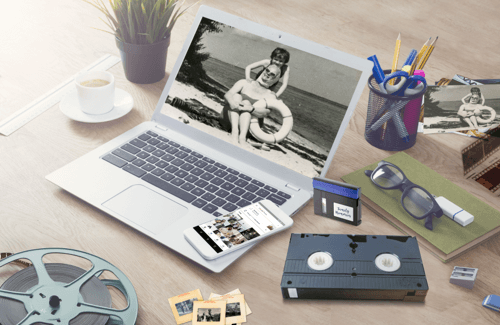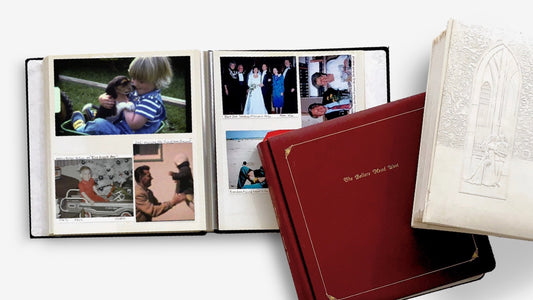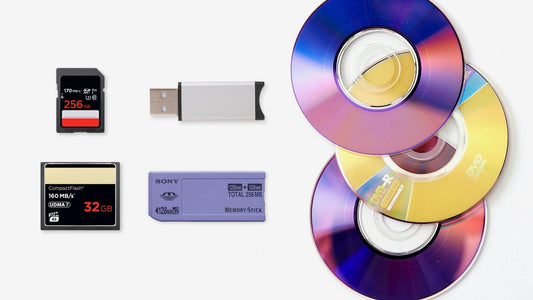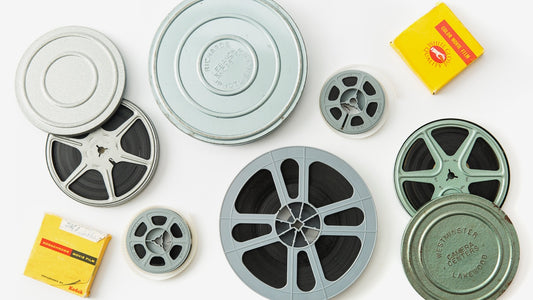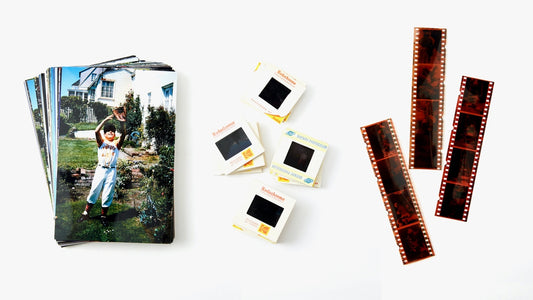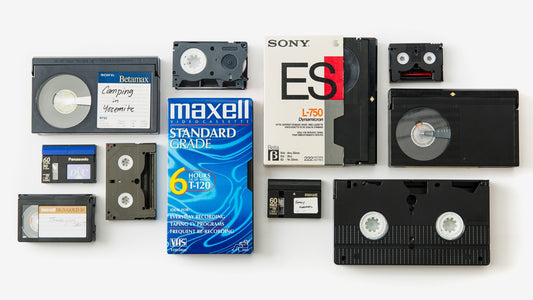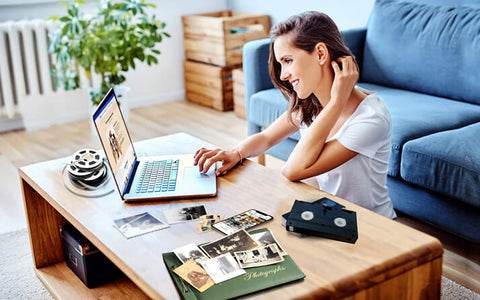That dusty box in your attic holds more than just old cassettes; it holds your family’s story. Many of those stories from the 1990s were recorded on Hi8 tapes, a compact format that offered a huge leap in quality over the bulky VHS camcorders of the time. They captured a whole generation’s worth of memories with surprising clarity. The problem is, the technology to play them has all but vanished. This leaves your most cherished moments trapped on an obsolete format. Here, we’ll cover how to identify your tapes, find ways to play them, and ultimately convert them into a digital format you can enjoy and share today.
Key Takeaways
- Hi8 Tapes Hold Superior Memories, But They're Trapped: Hi8 offered significantly better video quality than VHS, meaning your home movies from that era are likely clearer and more vibrant. The main challenge is that the tapes are degrading and the camcorders needed to play them are hard to find, putting those memories at risk.
- You Have Two Paths to Preservation: DIY or Professional: You can watch and convert your tapes at home if you can find a working camcorder and a video capture device. For a simpler, higher-quality result without the hassle of sourcing old equipment, a professional transfer service is the most reliable option.
- Digitization is the Only Permanent Solution: While careful storage helps, all magnetic tapes eventually deteriorate. Converting your Hi8 collection to a digital format like MP4 is the only way to permanently safeguard your memories from decay, making them easy to watch on any device and share with family.
What Are Hi8 Tapes?
If you have a box of home movies from the late ’80s or ’90s, there’s a good chance you’re looking at Hi8 tapes. These compact cassettes were the go-to format for families wanting to capture everything from birthday parties to soccer games. Think of them as the next step up from the earlier Video8 format, offering a significant improvement in video and audio quality that made memories feel more vibrant and clear.
Hi8 stands for High-Band Video8, and that "high-band" part is what made all the difference. It allowed for a sharper, more detailed picture than what people were used to with other consumer formats like VHS. The camcorders were also smaller and more portable, making it easier than ever to bring a video camera along for family vacations and special events. For many, Hi8 tapes represent a golden era of home video, holding precious moments that are now waiting to be rediscovered. The challenge today, of course, is that the technology to play them is no longer easy to find, making it essential to digitize them to keep those memories safe.
A Quick History: From Video8 to Hi8
The story of Hi8 begins with its predecessor, Video8. In the late 1980s, camcorder technology was evolving, and Hi8 emerged as the superior option. It offered better picture and sound quality, quickly making it a favorite among consumers through the 1990s and even into the early 2000s. This format hit the sweet spot, providing near-professional quality in a user-friendly package. While older formats required more cumbersome equipment, Hi8 made recording high-quality home movies accessible to everyone. This is why so many of our most cherished family memories from that time were captured on these little tapes, making a video transfer a popular way to preserve them.
Key Specs and Features
What exactly made Hi8 tapes so much better? It all comes down to resolution. Hi8 tapes could record with 400 lines of horizontal resolution, which was a huge leap forward from the 240 lines offered by standard VHS. This meant your videos looked sharper, with more detail and better color accuracy. The audio was also often recorded in higher fidelity. On top of the quality improvements, the tapes themselves were small and the camcorders were lightweight and easy to handle. This combination of quality and convenience is why Hi8 became the format of choice for so many families wanting to document their lives.
The Pros and Cons of Hi8
The biggest pro of Hi8 tapes is undoubtedly their video quality. When you convert them, you’ll notice that the footage is often clearer and more colorful than what you’d get from a VHS tape of the same era. Those memories were captured with a level of detail that still holds up surprisingly well.
The main con, however, is a big one: obsolescence. Hi8 camcorders are no longer manufactured, and finding one in good working condition can be a real challenge. The tapes themselves are also prone to degradation over time. This makes it difficult to simply watch your old home movies, let alone preserve them for the future. Without the right equipment, your memories are essentially trapped on those tapes.
What You Need to Play Hi8 Tapes
Rediscovering a box of old Hi8 tapes feels like finding a time capsule. Before you can dive into those memories, you’ll need to gather the right equipment. Since this technology is a few decades old, getting everything in working order can be a bit of a project, but it’s completely doable. Think of it as a treasure hunt for the tools that will bring your home movies back to life.
The most important piece of the puzzle is a compatible player. Without it, your tapes are just little plastic boxes. You'll also need the right cables to connect your player to a modern TV, and a few simple tools to make sure your gear is clean and won't damage your precious tapes. It’s worth taking the time to find equipment that’s in good shape, as a faulty player can do more harm than good. If hunting down and testing old electronics sounds like a hassle, remember that a professional video transfer service can handle the entire process for you. But if you’re ready for a little DIY, here’s exactly what you’ll need to get started.
Find the Right Player or Camcorder
First things first, you need a device that can actually play Hi8 tapes. The easiest option is a working Hi8 camcorder, but a Digital8 camcorder will also work, as they were designed to be backward-compatible. One thing to watch out for: a standard Video8 camcorder will not be able to play your Hi8 tapes. If you don’t have the original camcorder anymore, you can often find old 8mm camcorders at thrift stores, vintage shops, or online marketplaces like eBay. Just be sure to confirm that the device is in good working condition before you buy it, as you don’t want to risk a broken player eating your tapes.
Essential Cables and Accessories
Once you have a player, you’ll need a way to watch your footage. While you can use the small, flip-out screen on the camcorder itself, it’s much more fun to see your memories on a bigger screen. To connect your camcorder to a TV, you’ll need a set of AV cables—usually the ones with the red, white, and yellow plugs. Your camcorder should have corresponding output ports. You’ll also need the camcorder’s power adapter, since the original rechargeable batteries are likely long past their prime. Plug it in, connect it to your TV, and you’ll be ready for a viewing party.
Tools for Keeping Your Gear Clean
Old camcorders can gather a lot of dust over the years, and dirty playback heads can cause fuzzy pictures, distorted sound, or even damage your tapes. Before you pop in a tape, it’s a good idea to give your player a gentle cleaning. You can find special head-cleaning tapes designed for 8mm camcorders that you simply run for a few seconds. Another option is to use a can of compressed air to carefully blow out any dust from the tape compartment. Keeping your gear clean is a simple step that makes a huge difference in playback quality and helps preserve your tapes for years to come.
How to Play Your Hi8 Tapes
You’ve found a box of old Hi8 tapes—what a treasure! Now comes the fun part: watching them. Getting those memories off the tapes and onto a screen can feel like a puzzle, but you have a few great options, whether you still have the old equipment or not. Let's walk through the simplest ways to press play on your past.
Use the Original Camcorder
If you still have the camcorder you used to record the tapes, you’re in luck. This is often the most direct way to watch your home movies. Most camcorders can be connected directly to your television. You’ll typically need an RCA or A/V cable, which has yellow, red, and white plugs on each end. Just plug one end into the camcorder’s output ports and the other into your TV’s input ports. Once connected, switch your TV to the correct input source, pop in a tape, and press play. You can watch your memories right there in your living room, just like old times.
Other Ways to Watch Your Tapes
Don't have the original camcorder anymore? No problem. You can sometimes find dedicated Hi8 tape players or decks on sites like eBay. These devices were made specifically for playback and work just like a VCR, connecting easily to a TV. Another option, and often the simplest one, is to use a professional service to convert your videos to a modern digital format. This not only lets you watch your tapes without any special equipment but also preserves them for the future. Instead of hunting for old players, you can get your memories back as digital files that you can watch on any computer, phone, or smart TV and share with your whole family.
Fix Common Playback Problems
After years in storage, your Hi8 tapes might not play perfectly. You might see a fuzzy picture or hear distorted audio, which is often caused by dust and debris on the tape or the player’s heads. Using a head-cleaning tape can sometimes clear this up. Another common issue is a jammed or tangled tape. If this happens, don't force it. Try gently fast-forwarding and rewinding the tape a short distance to see if it loosens up. If a tape is visibly damaged or holds irreplaceable memories, it’s best to stop and let an expert handle it to avoid causing permanent damage.
How to Choose the Best Hi8 Tapes
If you’re still filming with your camcorder or getting ready to transfer old recordings, the quality of your tape really matters. A great tape ensures your memories are captured with clarity and are less likely to degrade over time. Choosing a reliable tape from the start can save you from the heartache of a damaged recording down the road, making the eventual video transfer process much smoother.
Reliable Brands to Look For
When shopping for Hi8 tapes, it’s smart to stick with brands that have a proven track record. Names like Sony, Fuji, and TDK are well-regarded for their quality and durability. Look for specific models like Sony P6-120HMPX Hi8 ProMP tapes, Fuji M221MP P6-120 tapes, or TDK 120 MP Superior or Premium Grade tapes. These options are often recommended by camcorder enthusiasts for their ability to maintain excellent video and audio quality, even after many years in storage.
What Makes a Good Quality Tape?
So, what makes one tape better than another? It comes down to the materials inside. The best Hi8 tapes use special 'ultra-fine metal particles' to produce a superior picture and richer sound. This technology also contributes to their durability. A high-quality Sony Hi8 tape, for example, was designed to retain its quality after being played up to 200 times. That kind of resilience is exactly what you need when you’re dealing with irreplaceable family moments.
Where to Buy Hi8 Tapes
You probably won’t find Hi8 tapes at your local big-box store anymore, but they are readily available online. Marketplaces like Amazon are a great resource, where a quick search for Hi8 tapes yields over 100 results. You can easily find tapes from trusted brands like Sony, Maxell, TDK, Panasonic, and Fujifilm. This makes it simple to compare prices, read reviews, and find single tapes or multi-packs that fit your needs, whether you’re capturing new memories or digitizing old ones.
What to Expect to Pay
The price for Hi8 tapes can vary widely, so it’s good to have a budget in mind. You can find single tapes for as low as $6, while sealed, professional-grade multi-packs can run over $215. The final cost depends on the brand, tape quality, and the quantity you’re buying. If you only need one or two tapes for a small project, you can find affordable options. If you’re planning a large recording session or have a big collection to transfer, buying in bulk might offer a better value.
How to Convert Your Hi8 Tapes to Digital
Your Hi8 tapes hold priceless family moments, from birthday parties to holiday gatherings. But as time goes on, these tapes degrade, and finding a working camcorder to play them becomes a challenge. Converting your tapes to a digital format is the best way to protect those memories from being lost forever. Once digitized, your home movies are safe from physical damage and can be easily watched, edited, and shared with loved ones on any modern device.
The conversion process might seem technical, but it's manageable once you understand your options. You can either tackle it yourself with the right equipment or hand it off to a professional service that specializes in preserving old media. Deciding which path to take depends on your budget, your technical comfort level, and how much time you're willing to invest. Let's walk through what you need to know to make the best choice for your precious memories.
DIY vs. Professional Conversion Services
Going the DIY route can be a rewarding project if you're comfortable with technology and have some patience. It gives you complete control over the process from start to finish. However, it requires tracking down a working Hi8 camcorder or player, purchasing specific cables and a video capture device, and dedicating time to transfer each tape in real-time. If your tapes are old or damaged, you also risk causing further harm without the right expertise.
If you don't have a camcorder or simply want to ensure the highest quality result without the hassle, professional video transfer services are an excellent alternative. These companies have the professional-grade equipment and experience to safely handle aging tapes, often producing a better digital copy than you could at home.
The Gear You Need for DIY Conversion
If you decide to convert your tapes yourself, you’ll need a few key pieces of equipment. First and foremost is a working Hi8 camcorder or deck that can play your tapes smoothly. Next, you'll need the correct cables (usually RCA or S-Video) to connect the camcorder to a video capture device. This device is the most important part of your setup; it acts as a bridge, connecting your analog camcorder to your computer's USB port. It takes the analog video signal from the tape and converts it into a digital file that your computer can read, save, and edit.
Choose the Right Digital Format
When you convert your Hi8 tapes, you’ll need to choose a digital file format for the final product. The most common and versatile option is MP4. This format offers a great balance between video quality and file size, making it perfect for storing on your computer or in the cloud. More importantly, MP4 files are universally compatible, meaning you can play them on almost any device—from your smartphone and tablet to your laptop and smart TV. Choosing MP4 ensures that your digitized memories will be easy to watch and share with family and friends for years to come.
Tips for Getting the Best Quality
To get the best possible quality from your conversion, start by cleaning the heads on your Hi8 camcorder or player before you begin. Dust and debris can cause static and dropouts in the video. If you're opting for a professional service, do a little research first. Look for a company with extensive experience handling Hi8 tapes specifically. Check customer reviews to gauge their reliability and quality, and make sure you understand their pricing, turnaround time, and whether they offer a quality guarantee. A reputable service will be transparent about its process.
Breaking Down the Costs
The cost of converting your Hi8 tapes can vary significantly depending on the method you choose. For a DIY project, you might spend anywhere from $40 to over $150 on a video capture device and any necessary cables. If you don't have a working camcorder, you'll also need to factor in the cost of buying a used one. On the other hand, professional services typically charge on a per-tape basis, often ranging from $25 to $30 per tape. While the upfront cost may seem higher, it saves you the time and expense of buying your own equipment and guarantees a high-quality, hassle-free result.
How to Preserve Your Hi8 Collection
Your Hi8 tapes are more than just plastic and magnetic tape; they’re irreplaceable windows into the past, holding birthdays, holidays, and everyday moments you can’t get back. But because they are physical objects, they are vulnerable to the effects of time. The magnetic tape inside can degrade, colors can fade, and sound can warp. The good news is that with a little care, you can protect these precious memories from further damage. Taking a few simple steps to store, handle, and maintain your collection properly can make all the difference, giving you the time you need to secure them for good. Think of it as first aid for your home movies—these tips will help you keep them stable and safe until you’re ready to preserve them permanently.
The Best Way to Store Your Tapes
Where you keep your Hi8 tapes has the biggest impact on how long they’ll last. The ideal environment is a cool, dry place with a stable temperature. Avoid attics, basements, or garages, where extreme heat, cold, and humidity can cause the magnetic tape to become brittle or grow mold. Direct sunlight is also a major enemy, as it can damage the plastic casing and the tape itself. The best spot is often a closet in the main part of your house. For an extra layer of protection, keep your tapes in their original protective cases to shield them from dust, debris, and accidental bumps.
How to Handle Tapes Safely
Handling your Hi8 tapes with care is a simple but crucial step. When you pick one up, always hold it by the outer plastic shell. Try your best to avoid touching the shiny magnetic tape that’s visible through the small windows, as oils and dirt from your fingers can cause permanent damage and playback errors. It’s also smart to keep your tapes away from anything with a strong magnetic field, like speakers, televisions, or other electronics. A powerful magnet can erase or distort the footage on your tapes in an instant, so it’s better to be safe and store them separately.
Simple Cleaning and Maintenance Tips
Keeping your playback equipment clean is just as important as caring for the tapes themselves. A dirty camcorder or VCR can transfer dust and grime onto the tape, leading to poor picture quality or even permanent damage. Before you play an old tape, it’s a good idea to clean the heads of your device. You can do this easily with a special head-cleaning cassette, which you can find online. Running one of these through your player for a few seconds can clear away years of buildup. This simple maintenance step helps ensure you get the best possible picture and sound from your tapes.
Spot the Warning Signs of Tape Damage
Your tapes will often give you visual clues when they’re starting to degrade. If you notice the picture looks fuzzy, snowy, or distorted during playback, it’s a major red flag. You might also see color bleeding, weird streaks across the screen, or hear muffled or warped audio. These are all signs that the magnetic tape is deteriorating. Don’t ignore these warnings. If you see them, it means the tape is in a fragile state and playing it further could cause more damage. It’s a clear signal that the clock is ticking, and it’s time to act quickly to save the memories on it.
How to Prevent Future Damage
Ultimately, the only way to permanently protect your Hi8 memories from fading away is to convert them to a digital format. Physical tapes will inevitably degrade over time, no matter how well you store them. Digitizing your collection creates a perfect, timeless copy that won’t wear out, fade, or get damaged by a faulty player. Once your home movies are digital, you can easily watch them on any device, share them with family online, and create backups for safekeeping. A professional video transfer service is the safest and most reliable way to ensure your memories are preserved for generations to come.
How Hi8 Compares to Other Formats
If you’ve found a box of old tapes, you might be looking at a mix of formats from different eras. Hi8 was a popular choice for home movies, but it existed alongside other major players like VHS and was eventually followed by a digital version. Understanding how Hi8 stacks up against these other formats can help you appreciate the quality of your tapes and figure out the best way to preserve them. Each format had its own strengths and weaknesses, from picture clarity to the size of the camcorder you had to carry around.
Hi8 vs. VHS
The biggest difference between Hi8 and VHS comes down to video quality. Hi8 tapes offered a significantly sharper picture, delivering around 400 lines of horizontal resolution compared to the 240 lines typical of VHS. This means your Hi8 home movies will look clearer and more detailed than recordings made on a standard VHS camcorder from the same time. Another obvious difference is the size. Hi8 tapes are tiny and compact, which allowed for smaller, more portable camcorders. This made it easier for families to capture memories on the go, from birthday parties to vacations, without lugging around bulky equipment. If you have a collection of different tapes, a video transfer service can handle them all.
Hi8 vs. Digital8
In 1999, Sony introduced Digital8 as the next step in the 8mm tape family. As the name suggests, Digital8 recorded video and audio digitally onto the tape, while Hi8 was an analog format. This leap to digital resulted in even better quality, boasting 500 lines of resolution and crisp digital stereo sound. One of the most helpful features of Digital8 camcorders was that many were backward-compatible, meaning they could play older Hi8 and Video8 tapes. However, the reverse isn't true—you can't play a Digital8 tape in a Hi8 camcorder. This made it easier for people to transition to the new format without losing access to their old library of memories.
Which Format Lasts Longer?
When it comes to physical lifespan, all magnetic tapes—whether Hi8, VHS, or Digital8—face the same enemy: time. These tapes weren't designed to last forever and will degrade over a couple of decades, leading to color loss, fuzzy audio, and brittleness. No single format is magically more durable than another. The real challenge today is finding working equipment to play them. While some Digital8 camcorders can play Hi8 tapes, these players are also aging. The only guaranteed way to make your memories last is by digitizing your tapes, which creates a permanent, high-quality copy that won't fade over time and is easy to share with your family.
Find a Professional Hi8 Conversion Service
If the DIY route feels a bit daunting, don't worry. Entrusting your precious Hi8 tapes to a professional service is a fantastic way to ensure they’re converted with care and expertise. When you’re dealing with one-of-a-kind family memories, sometimes it’s best to leave it to the pros. They have the right equipment and experience to handle delicate, aging tapes and produce high-quality digital files that your family can enjoy for years to come. A professional service saves you the time and hassle of sourcing equipment and learning the technical ropes, letting you focus on the fun part: reliving your favorite moments.
What Services Do They Offer?
At their core, professional video transfer services specialize in converting your analog Hi8 tapes into modern digital formats. The most common options you’ll see are MP4 files, which are perfect for storing on your computer, sharing online, or streaming to your TV. Many services, including YesVideo, offer a digital download link, a USB drive with all your files, or a set of DVDs. This flexibility allows you to choose the format that best fits how you want to watch and preserve your memories. Some companies also offer minor touch-ups, like color correction, to help restore your footage to its original vibrancy.
How to Choose a Trusted Company
Handing over your home movies can feel like a big deal, so finding a company you trust is key. Start by looking into their specific experience with Hi8 tapes. Check out customer reviews on their website and third-party sites to see what others have said about their quality and service. It’s also wise to compare pricing and understand their typical turnaround time. Most importantly, look for a company that is transparent about its process. Knowing your tapes are being handled carefully by experienced technicians, like the team at YesVideo who processes every order by hand, provides invaluable peace of mind.
Look for Quality Guarantees
A quality guarantee is a company’s promise that you’ll be happy with the final product. When you’re preserving memories, you want them to look and sound as clear as possible. A reputable service should stand behind its work. Look for companies that offer clear information on the resolution of their digital files and the equipment they use. A quality guarantee ensures that if there’s a correctable issue with the transfer, the company will work to make it right. This commitment shows they value your memories as much as you do and are dedicated to creating a digital keepsake you’ll cherish.
Understand the Cost of Professional Services
The cost of professional conversion can vary, but you can generally expect to pay around $25 to $30 per tape. Think of it as an investment in protecting your family’s history for future generations. This price typically covers the entire video transfer process, from carefully inspecting and cleaning your tape to the final digitization. Some companies may offer tiered pricing based on tape length or desired resolution, so be sure to read the details. While it might seem like a lot upfront, the cost of losing those memories to tape degradation is far greater.
How to Troubleshoot Common Hi8 Problems
Working with older media formats like Hi8 tapes can sometimes feel like a delicate operation. Tapes get stuck, players refuse to cooperate, and the picture quality isn’t always what you remember. These issues are common, but don’t panic. Many problems have simple fixes you can try at home before you worry that your memories are lost. A little patience and a gentle touch can often get your home movies playing again.
The good news is that you don't need to be a tech expert to solve most playback issues. From tangled tapes to fuzzy picture quality, a few simple steps can help you identify the problem and find a solution. Whether it's a quick cleaning or a simple adjustment, you might be surprised at what you can fix on your own. Here’s how to handle some of the most frequent Hi8 tape and player issues.
Fix Jammed or Tangled Tapes
There’s nothing more stressful than hearing a strange noise from your camcorder and realizing the tape is stuck. If a tape is jammed or tangled, your first instinct might be to pull it out, but that can cause permanent damage. Instead, try gently fast-forwarding the tape for a few seconds, then rewinding it. Sometimes, this simple back-and-forth motion is enough to loosen the tape and get it moving correctly again. If the cassette won’t eject, don’t force it. Try the fast-forward and rewind trick a couple more times. If it’s still stuck, it might be time to stop and get a professional opinion to avoid tearing the tape.
What to Do When Your Player Won't Work
If your camcorder or player won’t turn on or play a tape, start with the basics. Check that the power cord is securely plugged in and that the battery is charged. Sometimes the problem is that simple! If the power is fine but the player still won’t work, the device itself may have failing internal parts, which is common in older electronics. Remember that tapes themselves can also be the problem. Over time, the magnetic tape can degrade and shed particles that clog the player’s mechanisms. If you’ve tried multiple tapes and the player still isn’t working, you may need to have the device serviced or find a replacement.
Solve Poor Picture and Sound Quality
Are your videos appearing fuzzy, distorted, or snowy? This is a classic sign of tape degradation. Hi8 tapes store information on a delicate magnetic layer, and over decades, that layer can begin to break down. This causes the picture and sound quality to suffer. One thing you can try is cleaning the heads of your camcorder or player. You can use a special head-cleaning cassette or, very carefully, a cotton swab with a bit of isopropyl alcohol. This can remove dust and residue that might be interfering with playback. However, if the tape itself is deteriorating, the only way to stop further loss is through a video transfer to a stable digital format.
When It's Time to Call an Expert
Sometimes, a problem is beyond a simple DIY fix. If your tape is visibly snapped, twisted, or moldy, or if the cassette shell is broken, trying to play it can cause irreversible damage. This is the point where it’s best to step away and call in a professional. Experts have the specialized equipment and clean-room environments needed to safely repair and handle fragile tapes. For your most precious and irreplaceable memories, a professional digitization service is the safest bet. They can often rescue footage from damaged tapes and will ensure the highest-quality transfer, preserving your home movies for many more years to come.
Related Articles
- How to Convert Hi8 Digital: A Step-by-Step Guide – YesVideo
- Convert Hi8 to Digital: Your 3 Best Options – YesVideo
- Best VHS Video to Digital Converters: Top Picks – YesVideo
- The Best Digital 8mm Converter: A Buyer's Guide – YesVideo
- How to Digitize 8mm Film: Pro vs. DIY Guide – YesVideo
Frequently Asked Questions
What's the biggest risk of waiting to convert my Hi8 tapes? The main risk is that the magnetic tape inside the cassettes is slowly breaking down. This natural aging process can cause the colors in your videos to fade and the picture to become fuzzy or full of static. In some cases, the tape can become so brittle that it snaps when you try to play it. The longer you wait, the more of that precious video quality you stand to lose forever.
Can I just use any old 8mm camcorder to play my Hi8 tapes? Not exactly. You need a device that is specifically made for the Hi8 format. Your original Hi8 camcorder is your best option, but a Digital8 camcorder will also work since most were built to be backward-compatible with older Hi8 tapes. A standard Video8 camcorder, however, will not be able to play your Hi8 recordings, so it's important to check the model you have.
Will my digitized videos look as good as the original tapes? Yes, and in many cases, they can look even better. Professional transfer services use high-end equipment that is often far superior to the original camcorders the home movies were filmed on. This can produce a digital version that is clearer and more stable than what you might see playing the tape at home. The goal is to capture your footage at its highest possible quality before any more time-related damage occurs.
Is it really worth the cost to have a professional service convert my tapes? It really depends on what your time and peace of mind are worth to you. While you can convert tapes yourself, the process involves hunting down working equipment, buying specific hardware, and dedicating hours to transfer each tape individually. A professional service takes care of all the technical work for you and has the experience to safely handle fragile tapes, which is a huge relief when you're dealing with one-of-a-kind memories.
My tapes look fine, but the picture is snowy when I play them. Are they ruined? Probably not! A snowy picture is a classic sign that the magnetic tape is beginning to age, but it doesn't mean the footage is gone for good. The problem could simply be dirty playback heads on your camcorder, which a head-cleaning tape can often fix. If cleaning doesn't solve it, that's a clear signal that the tape itself is deteriorating and should be digitized soon to preserve the memories before the quality gets worse.





